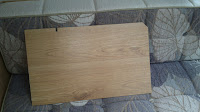This amazing little yellow box of electronics takes over the running of your water pump from the always-dodgy pressure switch. No more pulsing, and no more pump running dry!
The instructions make installation look simple - as they would be but for the way Baileys plumbed the original inlet. In fact access, through a hole in a wardrobe shelf, was always going to be tricky.
 |
| Extract from the Whale installation instructions |
The elbow that they used to connect the internal pipework ran tightly across the back of the inlet, so none of the bits and pieces could readily be accessed. This was resolved after discussions with Whale's tech support by removing the elbow and putting a straight connector and a short length of rigid pipe (supplied by Whale, thanks guys) between the inlet and the elbow.
 |
| The IC wired and ready to install |
 |
| The complete assembly |
In use, the water flow is much smoother, but I haven't tried the "run dry" feature yet.















